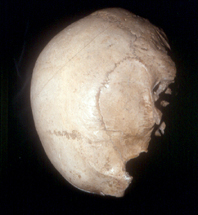 Anthropologists have long considered the
first occurrences of figurative art and body ornamentation to mark the earliest
modern human culture, called the Aurignacian, which existed 35,000 years ago.
The link, however, between these Ice Age craftspeople and their art has been
slowly disintegrating, as anthropologists redate the human remains associated
with the artifacts. One of the remaining links — the Vogelherd Cave, a
prominent German archaeological site — may also no longer hold, with new
radiocarbon dates revealing a 30,000-year discrepancy between the art and the
human remains long thought to represent the artists.
Anthropologists have long considered the
first occurrences of figurative art and body ornamentation to mark the earliest
modern human culture, called the Aurignacian, which existed 35,000 years ago.
The link, however, between these Ice Age craftspeople and their art has been
slowly disintegrating, as anthropologists redate the human remains associated
with the artifacts. One of the remaining links — the Vogelherd Cave, a
prominent German archaeological site — may also no longer hold, with new
radiocarbon dates revealing a 30,000-year discrepancy between the art and the
human remains long thought to represent the artists.In 1931, archaeologist Gustav Riek found this human cranium in the Vogelherd Cave in southwestern Germany and dated it to the same time period as carved ivory figurines from the earliest modern Europeans more than 35,000 years ago. However, archaeologists recently redated the skull and other human bones from the site and found the bones to be less than 5,000 years old. Photo courtesy of Fred Smith.
In the summer of 1931, Gustav Riek excavated a newly discovered archaeological site in a small cave in southwestern Germany called Vogelherd. He and his team recovered several hominid bones and remarkable artifacts, such as a carved ivory horse, mammoth and bison, which he dated to the Aurignacian.
“We felt we should check the Vogelherd specimens in light of other redatings of human remains once thought to be associated with the early Aurignacian,” says Fred H. Smith, an anthropologist at Loyola University in Chicago. So Smith and collaborator Nick Conard of the University of Tübingen in Germany examined five of the human bones recovered by Riek, including two skulls, a jaw and an arm bone. They were surprised to find that the bones were not 35,000 years old as Riek had suggested, but were instead between 3,900 to 5,000 years old, as they report in the July 8 Nature. “I had a suspicion the bones might be younger than early Aurignacian, but I never imagined they would be Neolithic,” Smith says.
The new dates on the human bones do not call into question the age of the archaeological material (which was previously radiocarbon-dated to the Aurignacian period), Smith says. He, Conard and third author Peter Grootes thus concluded that Neolithic humans unknowingly buried their dead near the entrances to Vogelherd Cave amidst relics of times long gone, and that is why Riek found the bones stratigraphically located next to older artifacts.
The new dates and weakening links between human remains and Aurignacian artifacts could call into question whether modern humans even produced the artifacts, or whether Neanderthals, who were also living in Europe at the time, could have produced the figurines, the authors say.
“The bones don’t go with the stones, but that doesn’t prove or disprove anything about whether Neanderthals could have produced the artifacts,” says Clark Howell, a professor emeritus in the Laboratory of Human Evolutionary Studies at the University of California, Berkeley. Archaeologists have not found art associated with Neanderthal sites, he says, and there are still sites with both Aurignacian artifacts and human bones.
“I’m completely stunned by the conclusion — that the authors think that the early Aurignacian artifacts could have been produced by Neanderthals,” says Jean-Jacques Hublin, director of the department of human evolution at the Max Planck Institute for Evolutionary Anthropology in Germany. “It is great” that the researchers are reevaluating the site and getting valid dates, but, Hublin says, agreeing with Howell, a lack of evidence that modern humans produced the figurines does not provide evidence that Neanderthals did.
Still, the weakening link means that “we should not exclude [Neanderthals] as the possible” artists, Smith says. He says that he hopes that the Nature paper will make people think at least, and maybe “encourage looking outside the lines of currently accepted dogma about the origin of the Aurignacian.” And this is good, he says, because the old ideas “weren’t getting us any closer to an answer.” Now researchers need to find and excavate more sites from this time period, as well as continue to re-date previously excavated sites, Smith adds.
Reevaluating old dates of sites is quite valuable, Hublin says, and is an exciting trend in paleoanthropology right now. But one thing to keep in mind, he says, is that as the dating technology continually evolves, “we’ll keep getting new dates, tomorrow and the day after.”

